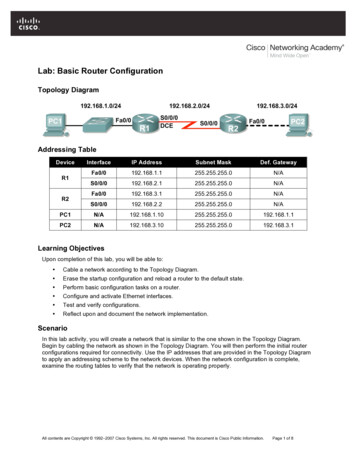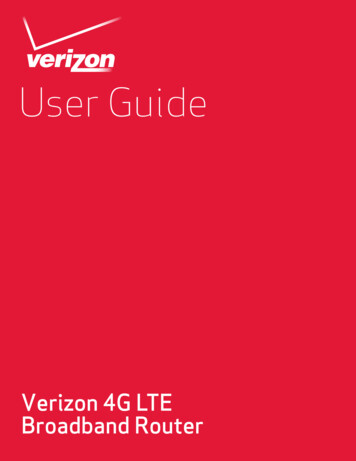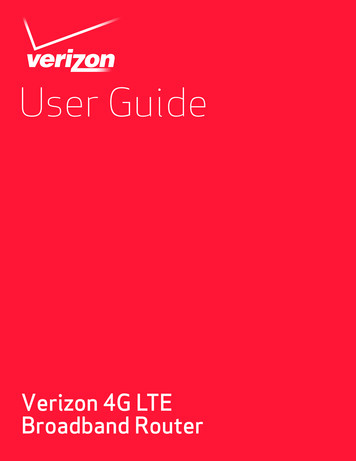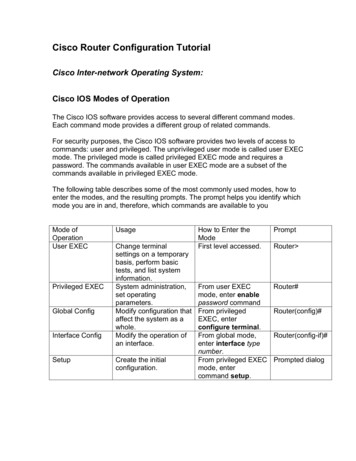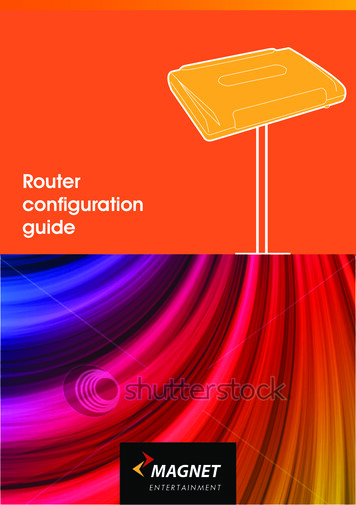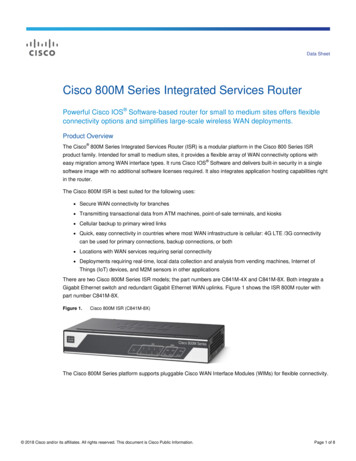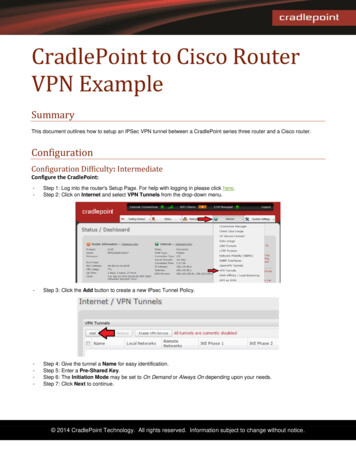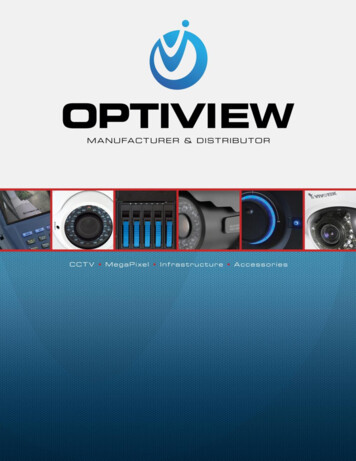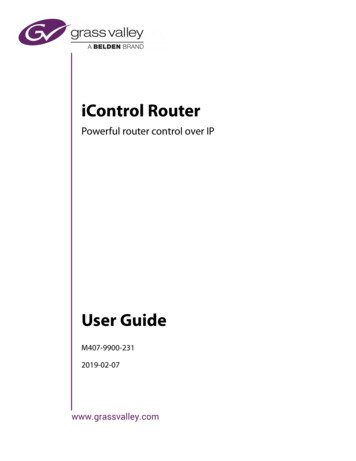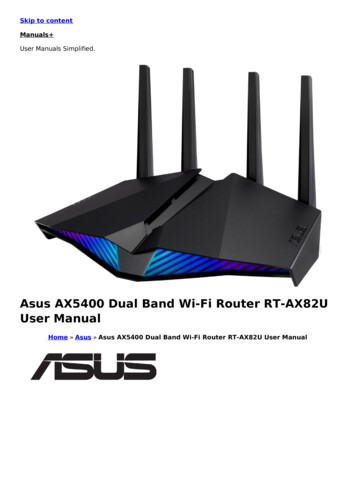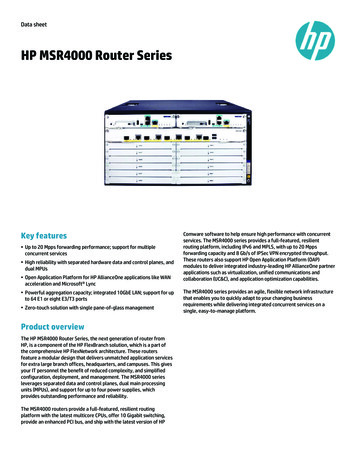
Transcription
Data sheetHP MSR4000 Router SeriesKey features Up to 20 Mpps forwarding performance; support for multipleconcurrent services High reliability with separated hardware data and control planes, anddual MPUs Open Application Platform for HP AllianceOne applications like WANacceleration and Microsoft Lync Powerful aggregation capacity; integrated 10GbE LAN; support for upto 64 E1 or eight E3/T3 ports Zero-touch solution with single pane-of-glass managementProduct overviewThe HP MSR4000 Router Series, the next generation of router fromHP, is a component of the HP FlexBranch solution, which is a part ofthe comprehensive HP FlexNetwork architecture. These routersfeature a modular design that delivers unmatched application servicesfor extra large branch offices, headquarters, and campuses. This givesyour IT personnel the benefit of reduced complexity, and simplifiedconfiguration, deployment, and management. The MSR4000 seriesleverages separated data and control planes, dual main processingunits (MPUs), and support for up to four power supplies, whichprovides outstanding performance and reliability.The MSR4000 routers provide a full-featured, resilient routingplatform with the latest multicore CPUs, offer 10 Gigabit switching,provide an enhanced PCI bus, and ship with the latest version of HPComware software to help ensure high performance with concurrentservices. The MSR4000 series provides a full-featured, resilientrouting platform, including IPv6 and MPLS, with up to 20 Mppsforwarding capacity and 8 Gb/s of IPSec VPN encrypted throughput.These routers also support HP Open Application Platform (OAP)modules to deliver integrated industry-leading HP AllianceOne partnerapplications such as virtualization, unified communications andcollaboration (UC&C), and application optimization capabilities.The MSR4000 series provides an agile, flexible network infrastructurethat enables you to quickly adapt to your changing businessrequirements while delivering integrated concurrent services on asingle, easy-to-manage platform.
Features and benefitsPerformance Excellent forwarding performanceprovides forwarding performance up to 20 Mpps (13.4 Gb/s); meetsthe bandwidth-intensive application demands of enterprisebusinessesConnectivity Powerful aggregation capacitysupports integrated 10GbE LAN, and up to 64 E1 or eight E3/T3ports High-density port connectivityprovides up to eight interface module slots and up to four on-boardGigabit Ethernet and one 10GbE ports Powerful security capacityincludes an embedded hardware encryption accelerator to improveencryption performance; IPSec encryption throughput can be up to8 Gb/s with a maximum of 8,000 IPSec VPN tunnels Multiple WAN interfacesprovides traditional links with E1, T1, Serial, and ISDN; high-densityEthernet access with WAN Fast Ethernet and Gigabit Ethernet; andhigh-speed E3/T3, 155 Mb/s OC3 access optionsProduct architecture Packet storm protectionprotects against broadcast, multicast, or unicast storms withuser-defined thresholds Ideal multiservice platformprovides WAN router, Ethernet switch, firewall, VPN, and SIP/voicegateway all in one device Advanced hardware architectureprovides multicore processors, gigabit switching, and PCIE bus; dualMain Processing Units, four internal power supplies (N 1configuration), and internal and external CF cards are offered; newhigh-performance MIM modules (HMIM) supported New operation system versionships with new Comware v7 operating system delivering the latestin virtualization and routing Loopbacksupports internal loopback testing for maintenance purposes andan increase in availability; loopback detection protects againstincorrect cabling or network configurations and can be enabled on aper-port or per-VLAN basis for added flexibility USB interfaceuses USB memory disk to download and upload configuration/OSimage files; supports an external USB 3G/4G modem for a 3G/4GWAN uplink Open Application Platform architectureprovides unmatched application and services flexibility, with thepotential to deliver the functionality of multiple devices, creatingcapital and operational expense savings and lasting investmentprotection Flexible port selectionprovides a combination of fiber and copper interface modules,100/1000BASE-X support, and 10/100/1000BASE-T auto-speeddetection plus auto duplex and MDI/MDI-X Distributed architecture with separation of data and controlplanesdelivers enhanced fault tolerance and facilitates near continuousoperation and zero service disruption during planned or unplannedcontrol-plane events; service processing units (SPUs) perform dataforwarding, encryption/decryption, and analyzing/filtering of datapackets; main processing units perform route calculation, forwardtable maintenance, and configure and monitor the SPU Spanning Tree Protocol (STP)supports standard IEEE 802.1D STP, IEEE 802.1w Rapid SpanningTree Protocol (RSTP) for faster convergence, and IEEE 802.1sMultiple Spanning Tree Protocol (MSTP) Field-programmable gate array (FPGA)improves the bandwidth of SIC module slots from 100 Mb/s to 1000Mb/s, and improves uplink performance from 1 Gb/s to 10 Gb/s Multi Gigabit Fabric (MGF)eases utilization of the main processor by transmitting Layer 2packets directly via the MGF Main processing unit (MPU)provides 1 GbE management port; has default of 512 MB internal CFand 2 GB DDR3 memory Service processing units (SPU)includes four 1000BASE-T and four SFP (Combo) slots, two voiceprocessing module slots, and 2 GB DDR3 memory; SPU 200 also hasone 10GbE SFP slot2Layer 2 switching Internet Group Management Protocol (IGMP) and MulticastListener Discovery (MLD) protocol snoopingcontrols and manages the flooding of multicast packets in a Layer 2network Port mirroringduplicates port traffic (ingress and egress) to a local or remotemonitoring port VLANssupports up to 4,094 VLANS or IEEE 802.1Q-based VLANs sFlowallows traffic samplingLayer 3 routing Static IPv4 routingprovides simple manually configured IPv4 routing
Routing Information Protocol (RIP)uses a distance vector algorithm with UDP packets for routedetermination; supports RIPv1 and RIPv2 routing; includes loopprotection Open shortest path first (OSPF)delivers faster convergence; uses this link-state routing InteriorGateway Protocol (IGP), which supports ECMP, NSSA, and MD5authentication for increased security and graceful restart for fasterfailure recovery Border Gateway Protocol 4 (BGP-4)delivers an implementation of the Exterior Gateway Protocol (EGP)utilizing path vectors; uses TCP for enhanced reliability for the routediscovery process; reduces bandwidth consumption by advertisingonly incremental updates; supports extensive policies for increasedflexibility; scales to very large networks Intermediate system to intermediate system (IS-IS)uses a path vector Interior Gateway Protocol (IGP), which is definedby the ISO organization for IS-IS routing and extended by IETF RFC1195 to operate in both TCP/IP and the OSI reference model(Integrated IS-IS) Static IPv6 routingprovides simple manually configured IPv6 routing Dual IP stackmaintains separate stacks for IPv4 and IPv6 to ease the transitionfrom an IPv4-only network to an IPv6-only network design Routing Information Protocol next generation (RIPng)extends RIPv2 to support IPv6 addressing OSPFv3provides OSPF support for IPv6 BGP extends BGP-4 to support Multiprotocol BGP (MBGP), includingsupport for IPv6 addressing IS-IS for IPv6extends IS-IS to support IPv6 addressing IPv6 tunnelingallows IPv6 packets to traverse IPv4-only networks byencapsulating the IPv6 packet into a standard IPv4 packet; supportsmanually configured, 6to4, and Intra-Site Automatic TunnelAddressing Protocol (ISATAP) tunnels; is an important element forthe transition from IPv4 to IPv6 Multiprotocol Label Switching (MPLS)uses BGP to advertise routes across Label Switched Paths (LSPs),but uses simple labels to forward packets from any Layer 2 or Layer3 protocol, which reduces complexity and increases performance;supports graceful restart for reduced failure impact; supports LSPtunneling and multilevel stacks Multiprotocol Label Switching (MPLS) Layer 3 VPNallows Layer 3 VPNs across a provider network; uses MultiprotocolBGP (MP-BGP) to establish private routes for increased security;supports RFC 2547bis multiple autonomous system VPNs for addedflexibility; supports IPv6 MPLS VPN Multiprotocol Label Switching (MPLS) Layer 2 VPNestablishes simple Layer 2 point-to-point VPNs across a providernetwork using only MPLS Label Distribution Protocol (LDP); requiresno routing and therefore decreases complexity, increasesperformance, and allows VPNs of non-routable protocols; uses norouting information for increased security; supports Circuit CrossConnect (CCC), Static Virtual Circuits (SVCs), Martini draft, andKompella-draft technologies Routing policyallows custom filters for increased performance and security;supports ACLs, IP prefix, AS paths, community lists, and aggregatepoliciesLayer 3 services Address Resolution Protocol (ARP)determines the MAC address of another IP host in the same subnet;supports static ARPs; gratuitous ARP allows detection of duplicateIP addresses; proxy ARP allows normal ARP operation betweensubnets or when subnets are separated by a Layer 2 network User Datagram Protocol (UDP) helperredirects UDP broadcasts to specific IP subnets to prevent serverspoofing Dynamic Host Configuration Protocol (DHCP)simplifies the management of large IP networks and supports clientand server; DHCP Relay enables DHCP operation across subnetsQuality of Service (QoS) Hierarchical quality of service (HQoS)/Nested QoSmanages traffic uniformly, and hierarchically schedules traffic byuser, network service, and application; provides more granulartraffic control and quality assurance services than traditional QoS Traffic policingsupports Committed Access Rate (CAR) and line rate Congestion managementsupports FIFO, PQ, CQ, WFQ, CBQ, and RTPQ Weighted random early detection (WRED)/random early detection(RED)delivers congestion avoidance capabilities through the use of queuemanagement algorithms Other QoS technologiessupports traffic shaping, MPLS QoS, and MP QoS/LFISecurity Dynamic Virtual Private Network (DVPN)collects, maintains, and distributes dynamic public addressesthrough the VPN Address Management (VAM) protocol, making VPNestablishment available between enterprise branches that usedynamic addresses to access the public network; compared totraditional VPN technologies, DVPN technology is more flexible andhas richer features, such as NAT traversal of DVPN packets, AAAidentity authentication, IPSec protection of data packets, andmultiple VPN domains3
IPSec VPNsupports DES, 3DES, and AES 128/192/256 encryption, and MD5 andSHA-1 authentication Access control list (ACL)supports powerful ACLs for both IPv4 and IPv6; ACLs are used forfiltering traffic to prevent unauthorized users from accessing thenetwork, or for controlling network traffic to save resources; rulescan either deny or permit traffic to be forwarded; rules can be basedon a Layer 2 header or a Layer 3 protocol header; rules can be set tooperate on specific dates or times Terminal Access Controller Access-Control System (TACACS )delivers an authentication tool using TCP with encryption of the fullauthentication request, providing additional security Unicast Reverse Path Forwarding (URPF)allows normal packets to be forwarded correctly, but discards theattaching packet due to lack of reverse path route or incorrectinbound interface; prevents source spoofing and distributed attacks Network loginallows authentication of multiple users per port RADIUSeases security access administration by using a user/passwordauthentication server Network address translation (NAT)supports one-to-one NAT, many-to-many NAT, and NAT control,enabling NAT-PT to support multiple connections; supports blacklistin NAT/NAT-PT, a limit on the number of connections, session logs,and multi-instances Secure Shell (SSHv2)uses external servers to securely log in into a remote device; withauthentication and encryption, it protects against IP spoofing andplain text password interception; increases the security of SFTPtransfersConvergence Internet Group Management Protocol (IGMP)utilizes Any-Source Multicast (ASM) or Source-Specific Multicast(SSM) to manage IPv4 multicast networks; supports IGMPv1, v2, andv3 Protocol Independent Multicast (PIM)defines modes of Internet IPv4 and IPv6 multicasting to allowone-to-many and many-to-many transmission of information;supports PIM Dense Mode (DM), Sparse Mode (SM), andSource-Specific Mode (SSM) Multicast Source Discovery Protocol (MSDP)allows multiple PIM-SM domains to interoperate; is used forinter-domain multicast applications Multicast Border Gateway Protocol (MBGP)allows multicast traffic to be forwarded across BGP networks andkept separate from unicast traffic4Integration Embedded VPN and firewallprovides enhanced stateful packet inspection and filtering; deliversadvanced VPN services with Triple DES (3DES) and AdvancedEncryption Standard (AES) encryption at high performance and lowlatency, Web content filtering, and application prioritization andenhancement Embedded NetStreamimproves traffic distribution using powerful scheduling algorithms,including Layer 4 to 7 services; monitors the health status ofservers and firewalls SIP trunkingdelivers multiple concurrent calls on one link; the carrierauthenticates only the link, rather than carrying each SIP call on thelinkResiliency and high availability Backup Centeracts as a part of the management and backup function to providebackup for device interfaces; delivers reliability by switching trafficover to a backup interface when the primary one fails Virtual Router Redundancy Protocol (VRRP)allows groups of two routers to dynamically back each other up tocreate highly available routed environments; supports VRRP loadbalancing In-Service Software Upgrade (ISSU)lowers downtime caused by planned maintenance and softwareupgrades Embedded Automation Architecture (EAA)monitors the internal event and status of system hardware andsoftware, identifying potential problems as early as possible;collects field information and attempts to automatically repair theissues; based on the user configuration, onsite information will besent to technical support Multiple internal power supply slotsdelivers higher reliability with a maximum of four internal powersupplies, which can be installed Bidirectional Forwarding Detection (BFD)detects quickly the failures of the bidirectional forwarding pathsbetween two devices for upper-layer protocols such as routingprotocols and MPLS.Management HP Intelligent Management Center (IMC)integrates fault management, element configuration, and networkmonitoring from a central vantage point; built-in support forthird-party devices enables network administrators to centrallymanage all network elements with a variety of automated tasks,including discovery, categorization, baseline configurations, andsoftware images; the software also provides configurationcomparison tools, version tracking, change alerts, and more
Industry-standard CLI with a hierarchical structurereduces training time and expenses, and increases productivity inmultivendor installations Management securityrestricts access to critical configuration commands; offers multipleprivilege levels with password protection; ACLs provide telnet andSNMP access; local and remote syslog capabilities allow logging ofall access SNMPv1, v2, and v3provide complete support of SNMP; provide full support ofindustry-standard Management Information Base (MIB) plus privateextensions; SNMPv3 supports increased security using encryption Remote monitoring (RMON)uses standard SNMP to monitor essential network functions;supports events, alarm, history, and statistics group plus a privatealarm extension group FTP, TFTP, and SFTP supportoffers different mechanisms for configuration updates; FTP allowsbidirectional transfers over a TCP/IP network; trivial FTP (TFTP) is asimpler method using User Datagram Protocol (UDP); Secure FileTransfer Protocol (SFTP) runs over an SSH tunnel to provideadditional security Debug and sampler utilitysupports ping and traceroute for both IPv4 and IPv6 Network Time Protocol (NTP)synchronizes timekeeping among distributed time servers andclients; keeps timekeeping consistent among all clock-dependentdevices within the network so that the devices can provide diverseapplications based on the consistent time Information centerprovides a central repository for system and network information;aggregates all logs, traps, and debugging information generated bythe system and maintains them in order of severity; outputs thenetwork information to multiple channels based on user-definedrulesEase of deployment Zero-touch deploymentsupports both USB disk auto deployment and 3G SMS autodeploymentAdditional information OPEX savingssimplifies and streamlines deployment, management, and trainingthrough the use of a common operating system, thereby cuttingcosts as well as reducing the risk of human errors associated withhaving to manage multiple operating systems across differentplatforms and network layers Faster time to marketallows new and custom features to be brought rapidly to marketthrough engineering efficiencies, delivering better initial andongoing stability Green initiative supportprovides support for RoHS and WEEE regulationsWarranty and support 1-year Warranty 2.0advance hardware replacement with 10-calendar-day delivery(available in most countries) Electronic and telephone support (for Warranty 2.0)limited electronic and 24x7 telephone support is available from HPfor the entire warranty period; to reach our support centers, refer towww.hp.com/networking/contact-support; for details on theduration of support provided with your product purchase, refer towww.hp.com/networking/warrantysummary Software releasesto find software for your product, refer towww.hp.com/networking/support; for details on the softwarereleases available with your product purchase, refer towww.hp.com/networking/warrantysummary Management interface controlprovides management access through modem port and terminalinterface; provides access through terminal interface, telnet, or SSH Network Quality Analyzer (NQA)analyzes network performance and service quality by sending testpackets, and provides network performance and service qualityparameters such as jitter, TCP, or FTP connection delays; allowsnetwork manager to determine overall network performance anddiagnose and locate network congestion points or failures Role-based securitydelivers role-based access control (RBAC); supports 16 user levels(0 15) Standards-based authentication support for LDAPintegrates seamlessly into existing authentication services5
HP MSR4000 Router SeriesSpecificationsHP MSR4060 Router Chassis (JG403A)HP MSR4080 Router Chassis (JG402A)2 MPU (Main Processing Unit) slots2 MPU (Main Processing Unit) slots1 SPU (Service Processing Unit) slot1 SPU (Service Processing Unit) slot6 HMIM slots8 HMIM slots4 Power Supply slots4 Power Supply slots17.32(w) x 18.9(d) x 6.89(h) in (44 x 48 x 17.50 cm) (4U height)17.32(w) x 18.9(d) x 8.64(h) in (44 x 48 x 21.95 cm) (5U height)45.52 lb (20.65 kg)49.93 lb (22.65 kg)MPU-100, 2 cores RISC @ 1 GHz, 512 MB flash capacity, 2 GB DDR3 SDRAMMPU-100, 2 cores RISC @ 1 GHz, 512 MB flash capacity, 2 GB DDR3 SDRAMDesktop or can be mounted in a EIA standard 19-inch telco rack when used with therack-mount kit in the package.Desktop or can be mounted in a EIA standard 19-inch telco rack when used with therack-mount kit in the package.PerformanceThroughputup to 20 Mpps (64-byte packets)up to 20 Mpps (64-byte packets)Routing table size1000000 entries (IPv4), 1000000 entries (IPv6)1000000 entries (IPv4), 1000000 entries (IPv6)Forwarding table size1000000 entries (IPv4), 1000000 entries (IPv6)1000000 entries (IPv4), 1000000 entries (IPv6)EnvironmentOperating temperature32 F to 113 F (0 C to 45 C)32 F to 113 F (0 C to 45 C)Operating relative humidity5% to 90%, noncondensing5% to 90%, noncondensingNonoperating/Storage temperature-40 F to 158 F (-40 C to 70 C)-40 F to 158 F (-40 C to 70 C)PortsPhysical characteristicsWeightMemory and processorMountingNonoperating/Storage relative humidity 5% to 90%, noncondensingAltitudeup to 16,404 ft (5 km)Electrical characteristicsFrequency5% to 90%, noncondensingup to 16,404 ft (5 km)50/60 Hz50/60 HzMaximum heat dissipation285/347 BTU/hr (300.67/366.09 kJ/hr), lower number is with SPU-100 moduleinstalled; higher number is for SPU-200297/358 BTU/hr (313.33/377.69 kJ/hr), lower number is with SPU-100 moduleinstalled; higher number is for SPU-200Voltage100-120/200-240 VAC100-120/200-240 VACMaximum power rating300 W300 WNotesMaximum power rating and maximum heat dissipation are the worst-case theoreticalmaximum numbers provided for planning the infrastructure with fully loaded PoE (ifequipped), 100% traffic, all ports plugged in, and all modules populated.No default power supply is included in the chassis; a minimum of one/maximum offour power supplies should be ordered.Maximum power rating and maximum heat dissipation are the worst-case theoreticalmaximum numbers provided for planning the infrastructure with fully loaded PoE (ifequipped), 100% traffic, all ports plugged in, and all modules populated.No default power supply is included in the chassis; a minimum of one/maximum offour power supplies should be ordered.ReliabilityMTBF (years)178.66178.66SafetyUL 60950-1; AS/NZS 60950; EN 60825-1 Safety of Laser Products-Part 1; EN 60825-2Safety of Laser Products-Part 2; IEC 60950-1; CAN/CSA-C22.2 No. 60950-1-03; EN60950-1/A11; FDA 21 CFR Subchapter JUL 60950-1; AS/NZS 60950; EN 60825-1 Safety of Laser Products-Part 1; EN 60825-2Safety of Laser Products-Part 2; IEC 60950-1; CAN/CSA-C22.2 No. 60950-1-03; EN60950-1/A11; FDA 21 CFR Subchapter JEmissionsEN 55022 Class A; ICES-003 Class A; ANSI C63.4 2003; ETSI EN 300 386 V1.3.3; AS/NZSCISPR 22 Class A; EN 61000-4-2; EN 61000-4-3; EN 61000-4-4; EN 61000-4-5; EN61000-4-6; EN 61000-3-2:2006; EN 61000-3-3:1995 A1:2001 A2:2005; EMCDirective 2004/108/EC; FCC (CFR 47, Part 15) Class A; EN 55024:1998 A1:2001 A2:2003; EN 61000-4-11:2004; EN 61000-4-8:2001EN 55022 Class A; ICES-003 Class A; ANSI C63.4 2003; ETSI EN 300 386 V1.3.3; AS/NZSCISPR 22 Class A; EN 61000-4-2; EN 61000-4-3; EN 61000-4-4; EN 61000-4-5; EN61000-4-6; EN 61000-3-2:2006; EN 61000-3-3:1995 A1:2001 A2:2005; EMCDirective 2004/108/EC; FCC (CFR 47, Part 15) Class A; EN 55024:1998 A1:2001 A2:2003; EN 61000-4-11:2004; EN 61000-4-8:2001TelecomFCC part 68; CS-03FCC part 68; CS-03ManagementIMC - Intelligent Management Center; command-line interface; limited command-lineinterface; configuration menu; out-of-band management (RJ-45 Ethernet); SNMPManager; Telnet; RMON1; FTP; in-line and out-of-band; modem interface; out-of-bandmanagement (serial RS-232C or Micro USB); IEEE 802.3 Ethernet MIBIMC - Intelligent Management Center; command-line interface; limited command-lineinterface; configuration menu; out-of-band management (RJ-45 Ethernet); SNMPManager; Telnet; RMON1; FTP; in-line and out-of-band; modem interface; out-of-bandmanagement (serial RS-232C or Micro USB); IEEE 802.3 Ethernet MIBServices3-year, parts only, global next-day advance exchange (UW075E)3-year, parts only, global next-day advance exchange (UW075E)3-year, 4-hour onsite, 13x5 coverage for hardware (UW076E)3-year, 4-hour onsite, 13x5 coverage for hardware (UW076E)3-year, 4-hour onsite, 24x7 coverage for hardware (UW006E)3-year, 4-hour onsite, 24x7 coverage for hardware (UW006E)3-year, 4-hour onsite, 24x7 coverage for hardware, 24x7 SW phone support and SWupdates (UW009E)3-year, 4-hour onsite, 24x7 coverage for hardware, 24x7 SW phone support and SWupdates (UW009E)3-year, 24x7 SW phone support, software updates (UW012E)3-year, 24x7 SW phone support, software updates (UW012E)1-year, post-warranty, 4-hour onsite, 13x5 coverage for hardware (HR554E)1-year, post-warranty, 4-hour onsite, 13x5 coverage for hardware (HR554E)6
HP MSR4000 Router SeriesSpecifications (continued)HP MSR4060 Router Chassis (JG403A)HP MSR4080 Router Chassis (JG402A)1-year, post-warranty, 4-hour onsite, 24x7 coverage for hardware (HR555E)1-year, post-warranty, 4-hour onsite, 24x7 coverage for hardware (HR555E)1-year, post-warranty, 4-hour onsite, 24x7 coverage for hardware, 24x7 softwarephone support (HR556E)1-year, post-warranty, 4-hour onsite, 24x7 coverage for hardware, 24x7 softwarephone support (HR556E)4-year, 4-hour onsite, 13x5 coverage for hardware (UW077E)4-year, 4-hour onsite, 13x5 coverage for hardware (UW077E)4-year, 4-hour onsite, 24x7 coverage for hardware (UW007E)4-year, 4-hour onsite, 24x7 coverage for hardware (UW007E)4-year, 4-hour onsite, 24x7 coverage for hardware, 24x7 software phone (UW010E)4-year, 4-hour onsite, 24x7 coverage for hardware, 24x7 software phone (UW010E)4-year, 24x7 SW phone support, software updates (UW013E)4-year, 24x7 SW phone support, software updates (UW013E)5-year, 4-hour onsite, 13x5 coverage for hardware (UW078E)5-year, 4-hour onsite, 13x5 coverage for hardware (UW078E)5-year, 4-hour onsite, 24x7 coverage for hardware (UW008E)5-year, 4-hour onsite, 24x7 coverage for hardware (UW008E)5-year, 4-hour onsite, 24x7 coverage for hardware, 24x7 software phone (UW011E)5-year, 4-hour onsite, 24x7 coverage for hardware, 24x7 software phone (UW011E)5-year, 24x7 SW phone support, software updates (UW014E)5-year, 24x7 SW phone support, software updates (UW014E)3 Yr 6 hr Call-to-Repair Onsite (UW079E)3 Yr 6 hr Call-to-Repair Onsite (UW079E)4 Yr 6 hr Call-to-Repair Onsite (UW080E)4 Yr 6 hr Call-to-Repair Onsite (UW080E)5 Yr 6 hr Call-to-Repair Onsite (UW081E)5 Yr 6 hr Call-to-Repair Onsite (UW081E)1-year, 6 hour Call-To-Repair Onsite for hardware (HR558E)1-year, 6 hour Call-To-Repair Onsite for hardware (HR558E)1-year, 24x7 software phone support, software updates (HR557E)1-year, 24x7 software phone support, software updates (HR557E)Refer to the HP website at www.hp.com/networking/services for details on theservice-level descriptions and product numbers. For details about services andresponse times in your area, please contact your local HP sales office.Refer to the HP website at www.hp.com/networking/services for details on theservice-level descriptions and product numbers. For details about services andresponse times in your area, please contact your local HP sales office.7
Standards and Protocols(applies to all products in series)BGPRFC 1163 Border Gateway Protocol (BGP)RFC 1998 PPP Gandalf FZA Compression ProtocolRFC 4271 A Border Gateway Protocol 4 (BGP-4)RFC 1267 Border Gateway Protocol 3 (BGP-3)RFC 2439 BGP Route Flap DampingRFC 4273 Definitions of Managed Objects for BGP-4RFC 1657 Definitions of Managed Objects for BGPv4RFC 2547 BGP/MPLS VPNsRFC 4274 BGP-4 Protocol AnalysisRFC 1771 BGPv4RFC 2796 BGP Route ReflectionRFC 4275 BGP-4 MIB Implementation SurveyRFC 1772 Application of the BGPRFC 2842 Capability Advertisement with BGP-4RFC 4276 BGP-4 Implementation ReportRFC 1773 Experience with the BGP-4 ProtocolRFC 2858 BGP-4 Multi-Protocol ExtensionsRFC 4277 Experience with the BGP-4 ProtocolRFC 1774 BGP-4 Protocol AnalysisRFC 2918 Route Refresh CapabilityRFC 4360 BGP Extended Communities AttributeRFC 1965 BGP-4 confederationsRFC 3065 Autonomous System Confederations for BGPRFC 1997 BGP Communities AttributeRFC 3107 Support BGP carry Label for MPLSRFC 4456 BGP Route Reflection: An Alternative to FullMesh Internal BGP (IBGP)RFC 3392 Capabilities Advertisement with BGP-4RFC 4724 Graceful Restart Mechanism for BGPCPU DoS ProtectionRate Limiting by ACLsRFC 1155 Structure and Mgmt Information (SMIv1)RFC 1902 (SNMPv2)RFC 2576 (Coexistence between SNMP V1, V2, V3)RFC 1157 SNMPv1/v2cRFC 1908 (SNMP v1/2 Coexistence)RFC 2578-2580 SMIv2RFC 1305 NTPv3RFC 1945 Hypertext Transfer Protocol -- HTTP/1.0RFC 2579 (SMIv2 Text Conventions)RFC 1591 DNS (client)RFC 2271 FrameworkRFC 2580 (SMIv2 Conformance)RFC 2573 (SNMPv3 Applications)RFC 3416 (SNMP Protocol Operations v2)RFC 768 UDPRFC 2993 Architectural Implications of NATRFC 783 TFTP Protocol (revision 2)RFC 3011 The IPv4 Subnet Selection Option for DHCPRFC 4419 Diffie-Hellman Group Exchange for the SecureShell (SSH) Transport Layer ProtocolRFC 791 IPRFC 3022 Traditional IP Network Address Translator(Traditional NAT)RFC 4446 IANA Allocations for Pseudowire Edge to EdgeEmulation (PWE3)RFC 3027 Protocol Complications with the IP NetworkAddress TranslatorRFC 4447 Pseudowire Setup and Maintenance Using theLabel Distribution Protocol (LDP)RFC 3031 Multiprotocol Label Switching ArchitectureRFC 4448 Encapsulation Methods for Transport ofEthernet over MPLS NetworksDenial of service protectionDevice managementGeneral protocolsRFC 792 ICMPRFC 793 TCPRFC 826 ARPRFC 896 Congestion Control in IP/TCP InternetworksRFC 917 Internet SubnetsRFC 925 Multi-LAN Address ResolutionRFC 950 Internet Standard Subnetting ProcedureRFC 951 BOOTPRFC 959 File Transfer Protocol (FTP)RFC 1027 Proxy ARPRFC 1048 BOOTP (Bootstrap Protocol) vendorinformation extensionsRFC 1058 RIPv1RFC 1091 Telnet Terminal-Type OptionRFC 3036 LDP SpecificationRFC 3037 LDP (Label Distribution Protocol) ApplicabilityRFC 3046 DHCP Relay Agent Information OptionRFC 3063 MPLS Loop Prevention MechanismRFC 3137 OSPF Stub Router AdvertisementRFC 3168 The Addition of Explicit CongestionNotification (ECN) to IPRFC 3215 LDP State MachineRFC 3246 Expedited Forwarding PHBRFC 1093 NSFNET routing architectureRFC 3268 Advanced Encryption Standard (AES)Ciphersuites for Transport Layer Security (TLS)RFC 1141 Incremental updating of the InternetchecksumRFC 3277 IS-IS Transient Blackhole AvoidanceRFC 1142 OSI IS-IS Intra-domain Routing ProtocolRFC 1166 Internet a
eases security access administration by using a user/password authentication server Network address translation (NAT) supports one-to-one NAT, many-to-many NAT, and NAT control, enabling NAT-PT to support multiple connections; supports blacklist in NAT/NAT-PT, a limit on the number of connections, session logs, and multi-instances

